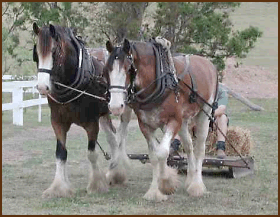
COMMON HORSE BREEDS
| CLYDESDALE
Origin: |
 Photo supplied by Lisborne Park Clydesdale Stud - NSW © |
History:
The Clydesdale originated in the Lanarkshire, Scotland where the river Clyde runs through.
During the second half of the 18th century imported Flemish stallions were used to improve
the stock of local farmers. Lawrence Drew and David Riddell were the leading breeders in
the 19th century and believed that the Clydesdale and the Shire horse were of the same
breed and regularly interbred them. The dark brown horse Prince of Wales, foaled in 1866,
was the most influential stallion in the development of the Clydesdale. Having a
combination of English and Scottish blood, he had outstanding action and demanded a high
stud fee, as his offspring was well sought after.
In 1877 the Clydesdale Horse Society was formed and a year later the first stud book
published. Interest in the breed was growing and large numbers of horses were exported to
North America, Australia, South America and Russia for farm and heavy haulage work.
Characteristics:
Head: strong head; broad forehead; wide muzzle; large
nostrils; bright eyes; big ears
Neck: long, well arched
Shoulders: sloping with high withers
Body: short back; well sprung ribs; muscular hindquarters
Legs: straight limbs; forelegs set well under shoulders; long
pasterns, fair measure of fine feather
Feet: round, open
Color: bay, brown and black, often with a large amount of
white on the face, limbs and stomach; chestnut is rare
Weight: approximately 1700 to 2200 pounds
Temperament: intelligent,
gentle, sensible, pleasant
Qualities: strong; brisk, ground covering paces; elegance and
great activity
Today:
Today the Clydesdale is renown for its great action. The Breeding Society says that the
inside of every horse shoe should be seen by someone walking behind the horse. Clydesdales
perform in the show ring and work on many race tracks hauling the starting stalls.
![]()